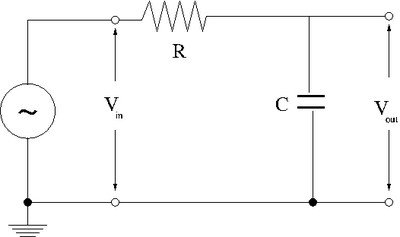Difference between revisions of "TF EIMLab3 Writeup"
| Line 64: | Line 64: | ||
|} | |} | ||
| − | + | 2.) Calculate and expression for <math>\frac{V_{out}}{ V_{in}}</math> as a function of <math>\nu</math>, <math>R</math>, and <math>C</math>. The Gain is defined as the ratio of <math>V_{out}</math> to <math>V_{in}</math>.(5 pnts) | |
| − | + | ||
| − | + | ||
| − | + | <math>V - IR -X_CI = =V -(X_R +X_C) I = 0</math> | |
| − | + | ||
| + | :<math>\Rightarrow</math> the capacitor can be added in series with the other resistor | ||
| + | |||
| + | :<math>X_{tot} = X_R + X_C</math> | ||
| + | |||
| + | It looks like the voltage divider from the resistance section | ||
| + | |||
| + | :<math>V_{out}= Re\left [\frac{X_C}{R+X_C} V_{in} \right ]= Re \left [\frac{X_C}{X_R+X_C} V_{in} \right ]</math> | ||
| + | |||
| + | To evaluate <math>Re[Z] = \sqrt{Z Z^*}</math> where<math> Z = x+iy</math> and <math>Z^* = x-iy</math> | ||
| + | |||
| + | |||
| + | :<math>\frac{V_{out}}{V_{in}} = Re \left [ \frac{\frac{1}{i \omega C}}{R+\frac{1}{i \omega C}} \right ] = \sqrt{\frac{\frac{1}{i \omega C}}{R+\frac{1}{i \omega C}} \frac{\frac{1}{-i \omega C}}{R+\frac{1}{-i \omega C}} } = \frac{1}{\sqrt{1 + \omega^2 R^2 C^2}}</math> | ||
| + | |||
| + | Let | ||
| + | :<math>\omega_b = \frac{1}{RC} =</math> break point (cut off ) frequency | ||
| + | |||
| + | then | ||
| + | |||
| + | :<math>\frac{V_{out}}{V_{in}} = \frac{1}{\sqrt{1 + \left ( \frac{\omega}{\omega_b}\right )^2}}</math> | ||
| + | |||
| + | 3.)Sketch the phasor diagram for <math>V_{in}</math>,<math> V_{out}</math>, <math>V_{R}</math>, and <math>V_{C}</math>. Put the current <math>i</math> along the real voltage axis. (30 pnts) | ||
| + | 4.)Compare the theoretical and experimental value for the phase shift <math>\theta</math>. (5 pnts) | ||
| + | 5.) what is the phase shift <math>\theta</math> for a DC input and a very-high frequency input?(5 pnts) | ||
| + | 6.) calculate and expression for the phase shift <math>\theta</math> as a function of <math>\nu</math>, <math>R</math>, <math>C</math> and graph <math>\theta</math> -vs <math>\nu</math>. (20 pnts) | ||
[[Forest_Electronic_Instrumentation_and_Measurement]] | [[Forest_Electronic_Instrumentation_and_Measurement]] | ||
Revision as of 06:11, 21 January 2011
- RC Low-pass filter
1-50 kHz filter (20 pnts)
1.)Design a low-pass RC filter with a break point between 1-50 kHz. The break point is the frequency at which the filter starts to attenuate the AC signal. For a Low pass filter, AC signals with a frequency above 1-50 kHz will start to be attenuated (not passed).
2.)Now construct the circuit using a non-polar capacitor. 3.)use a sinusoidal variable frequency oscillator to provide an input voltage to your filter. 4.)Measure the input and output voltages for at least 8 different frequencies which span the frequency range from 1 Hz to 1 MHz.
| Hz | Volts | Volts | |
| 50 | 0.6 | 0.3 | |
| 100 | 0.5 | 0.18 | |
| 250 | 0.5 | 0.075 | |
| 500 | 0.45 | 0.04 | |
| 1000 | 0.4 | 0.017 | |
| 2500 | 0.28 | 0.005 | |
| 5056 | 0.16 | 0.005 | |
- Graph the -vs-
phase shift (10 pnts)
- measure the phase shift between and
Questions
1.)compare the theoretical and experimentally measured break frequencies. (5 pnts)
\omega_{break} = \frac{1}{RC} = \frac{1}{400 \times 10^{3} \times 9.45 \times 10^{-9}} = = 2.6 \times 10^{2}
| Theory | Exp | %diff | |
2.) Calculate and expression for as a function of , , and . The Gain is defined as the ratio of to .(5 pnts)
- the capacitor can be added in series with the other resistor
It looks like the voltage divider from the resistance section
To evaluate where and
Let
- break point (cut off ) frequency
then
3.)Sketch the phasor diagram for ,, , and . Put the current along the real voltage axis. (30 pnts) 4.)Compare the theoretical and experimental value for the phase shift . (5 pnts) 5.) what is the phase shift for a DC input and a very-high frequency input?(5 pnts) 6.) calculate and expression for the phase shift as a function of , , and graph -vs . (20 pnts)
